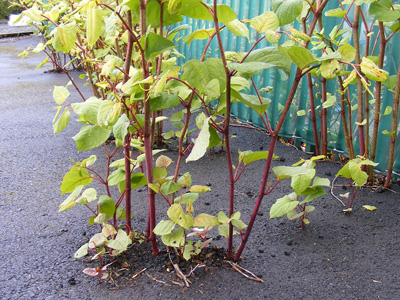
Managing Trustees need to be aware of the serious implications that can arise when Japanese Knotweed is found on land. Under the Wildlife and Countryside Act 1981, all property owners are required by law to control and prevent invasive non-native plants on their land from spreading into the wild, or spreading on to a neighbour’s property and causing a nuisance.
Japanese Knotweed is an extremely fast growing invasive species of plant, which is capable of growing through walls, drains, foundations and surface paving causing serious structural damage to properties. Its roots can spread up to 7 metres and once established its eradication is expensive and can take many years.
It is important that Managing Trustees can identify the plant so that if it is found on land belonging to the Methodist Church they can control it in the most appropriate way.
There is helpful guidance on the Government’s website on how to identify Japanese Knotweed as well as how to control and dispose of the same:
How to control and dispose of Japanese Knotweed
How to identify Japanese Knotweed
Managing Trustees do not have to remove Japanese knotweed from their land, but if they allow it to spread onto anyone else’s property then they could be prosecuted or given a community protection notice for causing a nuisance. Property owners can be fined or sent to prison for up to 2 years.
Aside from the risk of prosecution, Managing Trustees should also consider the serious implications that the contamination of Japanese Knotweed on Church land can have and how this could affect the ability to dispose of the property going forward. Prospective purchasers would be extremely reluctant to purchase a property contaminated with Japanese Knotweed due to the difficulties and expense of eradicating it and the risk of potential litigation.
Likewise, the Managing Trustees will also need to be aware of the legal implications arising from Japanese Knotweed encroaching onto their land from a neighbouring property and again the effect this will have on their ability to dispose of that property.
In recent case law (Waistell v Network Rail Infrastructure Ltd) a judgment was made in what is thought to be the first decided claim for damages arising from the existence of Japanese Knotweed. It was a decision made in the County Court and therefore not a binding decision, but it could open the floodgates for a large number of other claims, if it is challenged in the higher courts and upheld.
To summarise the case, Network Rail has been ordered to pay substantial damages for nuisance caused to two homeowners by its failure to control Japanese Knotweed. This decision was made despite no physical damage having been suffered by the claimants; the fact that the existence of Japanese Knotweed had simply made the property less attractive to prospective buyers and had diminished the likelihood of being accepted by lenders as security was sufficient.
Previously in most nuisance claims, the claimant must have suffered some actual physical damage or an unreasonable interference with their property rights, which caused the loss of enjoyment of their property. The judge’s decision in Waistell introduces the possibility that a claim can be pursued even where no actual damage has been sustained.
If Managing Trustees ever have any concerns in relation to the existence of Japanese Knotweed and the implications this could have, please do contact TMCP Legal and we will be more than happy to provide assistance.
